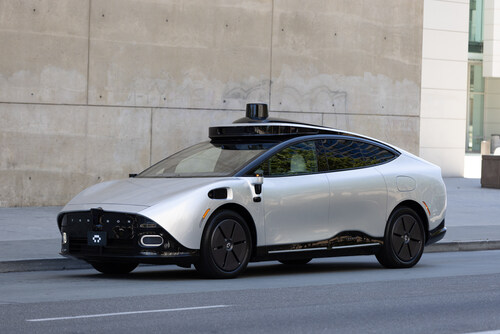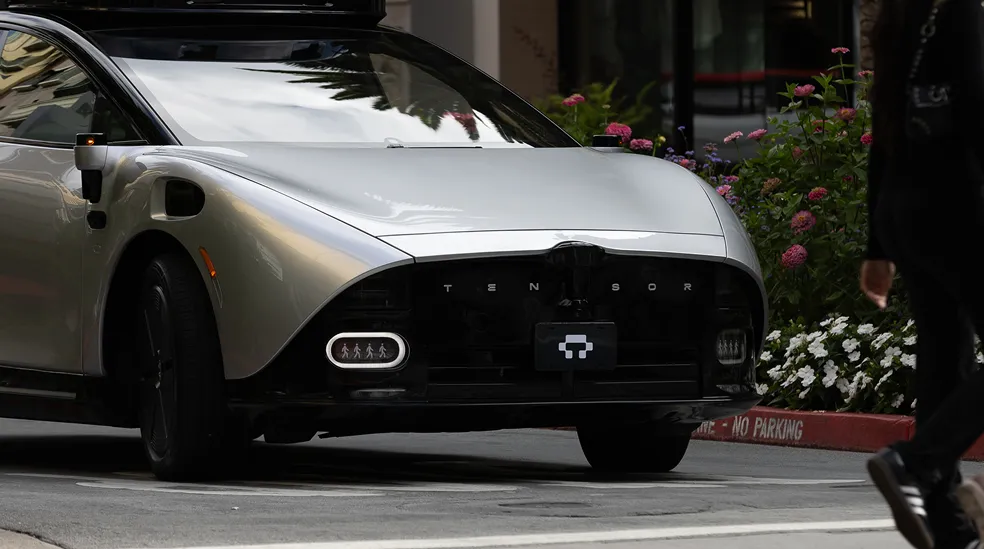The Tensor Robocar is the first Level-4 autonomous vehicle for personal ownership built from the ground up with advanced sensors, redundant systems, and Tensor’s proprietary AI. It introduces consumer-ready autonomy with self-maintenance and on-vehicle data privacy to usher in a new era of personal self-driving cars that outdo anything else on the market right now.
The first time I saw Tensor’s Robocar in person, I knew I was standing in front of something that would make future historians draw a clean dividing line: cars before the Robocar, and cars after the Robocar. From a distance, it looked familiar enough—sleek proportions, aerodynamic stance, typical modern design cues—but as I crossed the busy Manhattan street and stepped closer, I realized that this wasn’t designed for design’s sake. The contours and surfaces were dictated by sensors, not superficial styling departments. Every angle seemed to be about feeding data to the machine’s brain, whether it was the radar-transparent bodywork or the unobstructed sightlines for the lidar system. It did not at all feel like a car with sensors bolted on, but instead a machine whose entire form was shaped from the start by its need to perceive.
That philosophy extends into the details in a way that left me frankly stunned. Tensor didn’t stop at the usual radar-and-camera setup we’ve come to expect. The Robocar carries 37 cameras, 5 lidars, 11 radars, and an array of microphones, collision detectors, ultrasonic sensors—even water-level monitors. It’s an orchestra of perception, with each instrument working in tandem in perfect vertical integration. Most automakers patchwork systems haphazardly together from multiple suppliers. Tensor engineered everything in-house, from sensors to software to the redundant electrical backbone that ties it all together. The result feels aerospace-grade: triple 5G channels, dual IMUs, and fail-operational systems designed to assume that something will inevitably fail, but to still keep the vehicle moving safely regardless. This is not autonomy as an afterthought—it’s autonomy as DNA.

Tensor Robocar, courtesy of PRNewsfoto/Tensor
Of course, the real marvel is what Tensor’s Agentic AI does with all that information. Unlike the rule-bound systems we’ve seen distress under unusual conditions, the Tensor Foundation Model is built like a human mind in two layers. There’s the fast, reflexive “System 1,” trained by utilizing imitation learning on expert drivers, making split-second maneuvers with uncanny instinct. Then there’s the reasoning “System 2,” a multimodal visual language model that can chew through bizarre, unpredictable scenarios. In a glare-heavy simulation so blinding that older autonomous cars, much less humans, would freeze, the Robocar can keep rolling, calmly, confidently, as if nothing unusual had happened, due to the powerful sensors/radars working with its tactical reasoning system. Imagining this functionality, I couldn’t help but think that this was the first time I’ve ever felt like an AI was smart and capable enough to surpass a human driver in every way, and that I could actually put my trust in it.
Yet, what impressed me most wasn’t just the tech—it was the ownership model. For years, autonomy has meant fleets: vehicles that live in depots, cleaned and serviced by technicians. Tensor throws that entire business model out. This car is built for private ownership, equipped with self-cleaning sensors, retractable protective covers, autonomous charging, and self-diagnostic systems. It performs its own startup checks like a pilot’s preflight, only invisible and instant. There is no need to babysit it or send it to a depot every week. For the first time, autonomy is sitting in your driveway, not on a test track or in a Silicon Valley pilot zone (where the technology was coincidentally born, in San Jose). Tensor also makes a statement that’s rare in this industry: privacy as a foundation, not a feature. In an era when most cars feel like data-harvesting devices on wheels, the Robocar keeps everything local. Your trips, your preferences, and even your voice interactions stay encrypted on the vehicle itself. With hardware switches to cover cameras and cut off microphones, it’s clear that Tensor is taking an Apple approach to privacy: making it the number one priority. For people who want the future of mobility without giving away their digital selves, this may be Tensor’s quietest but most radical innovation.
There were then some touches that proved this wasn’t a sterile piece of tech, but a vehicle designed to be lived in. A foldable steering wheel that was an absolute joy to watch retract, a sliding display that gracefully covered the folded wheel, and a dual-mode operation from Level 0 to Level 4 autonomy that let me choose when to drive and how to be driven. It’s a subtle but profound shift: driving is no longer a duty—it’s an option, a pleasure to reclaim when wanted. Tensor isn’t killing the joy of driving; it’s reframing it.
Walking away from the showing of the vehicle, I realized I wasn’t just impressed—I was unsettled, in the best possible way. We’ve been promised the “car of the future” for decades, usually in the form of flashy prototypes or concepts that never survive contact with reality. Tensor’s Robocar doesn’t feel like a concept. It feels like the first production vehicle of a new era, one that will redefine not just how we move, but what it means to truly own a machine in the age of autonomy. Come late 2026, when these begin rolling into private garages in the UAE, EU, and US, the automotive world won’t just evolve—it will split, irrevocably, into what came before Tensor, and what comes after.
